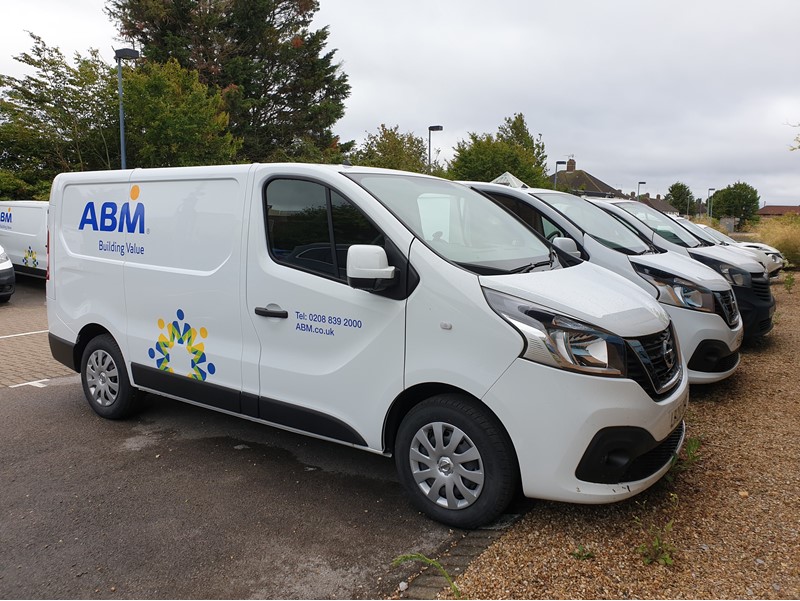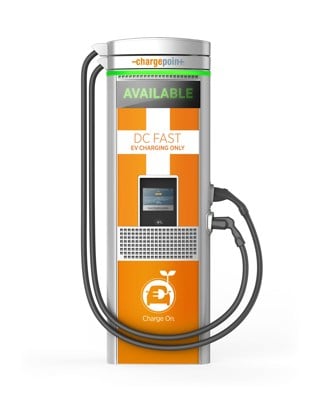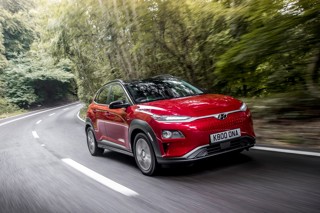As a facilities management provider working across more than 15 industries with a host of job roles, including cleaners, engineers and security officers, ABM has experienced both challenges and opportunities from the Covid-19 pandemic.
“It has been extremely tough on quite a few of our clients because some of them are in the retail industry and aviation sector. This has really hit them hard,” says fleet manager Denise Hawkins.
“But we’ve got clients in the public sector and transport industry who have been non-stop and there has been a lot of pressure on them to keep all of their employees safe as well as any members of the public. So it’s been an odd time with having to make cutbacks in some areas and having to boost capacity in others.”
Where possible, ABM has reallocated staff to keyworker sectors and has taken advantage of the Government’s Coronavirus Job Retention Scheme to furlough some employees.
ABM’s 230 light commercial vehicles remained busy throughout the crisis due to supporting keyworker sectors, with only a 12% reduction in operation, even during the height of lockdown. It is now close to being 100% operational again.
However, it’s the opposite situation with ABM’s 70 company cars. The majority are used by managers who have been working from home during lockdown and having virtual meetings using Microsoft Teams or other technology rather than driving to face-to-face meetings. The drivers have continued to have private use of the vehicles rather than the vehicles being mothballed, but mileages have, naturally, reduced.
The vehicles are contract hired and while none has reached end of contract yet, Hawkins plans to extend those that do on a case-by-case basis, with some going onto an informal, monthly rolling extension and others potentially being extended for four or six months.
Hawkins is also keeping an eye on which vehicles may need an MOT – not normally an issue as vehicles are, typically, kept for three years.
Service, maintenance and repair (SMR) is not a big headache for her as those vehicles which have been operational during lockdown have benefited from keyworker status and drivers have been able to access garages, although in some cases they have had to travel further to a repairer or wait a few days longer rather than having same-day or next-day availability.
The commercial fleet’s drivers have had to adapt in other ways during the crisis.
“There have been changes that have needed to be made from an operational level, but everyone has been extremely compliant,” Hawkins says.
No multiple occupants
Teams have been restricted so there are not multiple occupants in vehicles and pool vehicles have been limited to a single driver.
The pool vehicles are based on a site and, previously, anyone who needed to drive one during the shift to move things around on the site or to move from site to site was able to, with a log kept of who had been driving. During lockdown each vehicle was permanently allocated to one person.
Field staff were already used to wearing PPE such as gloves but there has been increased usage, as well as face masks when social distancing isn’t possible.
All employees, including those who were previously office-based, have been issued with a reusable face mask.
“We’ve been issuing new guidance and training on cleaning processes, making sure people are keeping the upmost cleanliness of their driving space – pointing out the key touchpoints and things like that,” Hawkins says.
“We’ve been having toolbox talks via mobile phones and Teams on mobile phones about those, as well as documentation filling out.”
The fleet team – Hawkins, road risk champion Edyta Idzior and junior fleet analyst and support Anthony Gaylor – have all been working from home, using Teams for a daily catch-up call. Hawkins says this serves as a “welfare check” as well as talking about any fleet-related issues.
“The company has been massively supportive of the remote workforce with a lot of advice and support on employee wellbeing,” Hawkins says.
Although ABM’s offices have been closed, it is in the process of re-opening them for people to use on a case-by-case basis, following deep cleaning and other safety measures.
“Not everyone has a perfect set-up at home,” Hawkins says. “There have been difficulties with not having access to all the phone systems or printing equipment and things that people require on a day-to-day basis. We have been able to find workarounds, but they are only workarounds so people that need to access equipment or for health and wellbeing reasons will be allowed back in.”
However, those who can work from home will continue to do so.
At clients’ sites, ABM has assisted in putting measures in place to operate safely such as sanitising stations, markers on the floor, barriers and one-way systems.
It has launched a new service called Enhanced Clean (essentially a deep clean), which staff have been trained to carry out using specialist machinery and chemicals.
“A lot of our clients have already taken it up and fleet is going to be providing the facilities to do those services,” Hawkins says. “It’s the world we’re in now, cleaning is no longer just something that gets done; it’s something people are actively paying attention to. As a cleaner, we’ve been pushed to the forefront.”
She adds: “In the past few years there has been a slow decline of fleet usage, within the facilities industry at least, but I feel like in this new world that we find ourselves in, fleet is starting to become a focus again. There is a general shift away from fleet being seen as just a cost. We’re not just wheels, we’re an essential service.”
One of the challenges of operating a fleet in the facilities industry is that the fleet size fluctuates dependent on contract wins and losses. Acquiring vehicles for a new contract is often done at short-notice. Replacement cycles run in line with contracts, typically three years.
On one occasion, Hawkins had to mobilise 210 vans with only two-and-half weeks’ notice.
It was combined with putting the fleet out to tender and one of the key factors was whether the lease provider could mobilise fully fitted-out vans within that timescale.
Arval won the tender and the majority of the vans were ready in time.
A very small percentage of the fleet is outright purchased – again dependent on contracts. For instance, vehicles that will be used only at a certain site tend to have low mileage and it is more economical for ABM to buy them. If the contract is not renewed, the client often buys the vehicles. Conversely, ABM may win a contract where the client already has vehicles and simply wants ABM to manage them.
New company car policy set to save £100,000
Like all professional fleet managers, Hawkins aims to make the fleet as efficient as possible and ABM is set to introduce a new fleet policy next month, with anticipated savings of £102,800.
The bulk of the savings (£45,500) comes from removing ‘free’ fuel, after calculations showed that it was not a benefit to drivers and was costing them more in tax.
The second biggest saving (£35,800) comes from grey fleet management and mileage reimbursement, with cash allowance drivers being paid the advisory fuel rate for business journeys rather than the 45p per mile AMAP rate as their allowance covers the cost of insurance, servicing and maintenance.
The third biggest saving (£13,500) is from switching the company car choice list from being based on monthly lease costs to wholelife costs, and thereby allowing electric and hybrid vehicles into lower bandings.
The remainder of the savings are expected to come from stipulating that drivers use a daily rental vehicle for business journeys of more than 100 miles rather than using their personal car..
The rental requirement has been introduced as part of a revised travel hierarchy, which has been altered, again in light of Covid-19.
“We have restricted travel to essential journeys only, in line with the Government guidelines,” Hawkins says. “We have also shifted the use of public transport down the list due to there being a higher risk of infection, and moved rental up.
“We’ve had virtually no travel, but as we move out of total lockdown for the short-to-medium term, rental will be the preferred use of travel within the hierarchy.”
Company car drivers have been able to order electric vehicles (EVs) from the start of the year and ABM is set to exceed its target of 10% of the car fleet becoming EV. Six are already on the fleet (three Jaguar I-Paces, a Hyundai Kona Electric, a Kia e-Niro, and a Tesla Model 3), and two more Tesla Model 3s are due to arrive before the end of the year.
There are also four hybrids (a Toyota C-HR Hybrid, Mitsubishi Outlander PHEV, Volkswagen Golf GTE and Hyundai Ioniq Hybrid).
Three of the pure EVs were ready to be delivered in March, but got stuck at dealerships when the lockdown came. They arrived last month.
Current lead times on vehicles are a mixed bag, according to Hawkins.
“On one hand, a lot of dealers and manufacturers have got vehicles sitting around that they would have sold over the past few months, and haven’t, so they have extra stock. Then other manufacturers, which only do factory orders, have orders going way into next year. So, it depends on what you want and from whom,” she says.
Hawkins isn’t able to encourage company car drivers to choose vehicles that are available sooner as “we don’t have a distinct list of what is available and what isn’t”.
“It’s a very unknown, uncertain time at the moment,” she adds.
Despite the uncertainty, she is confident ABM can meet its target of average CO2 emissions for the entire fleet being 100g/km or lower by 2023. Currently, the average is 139g/km (the car fleet has an average of 104g/km while vans are 153g/km).
Like many businesses, environmental concerns are high on the agenda and ABM has appointed a sustainability manager, Lara Coutinho.
“She has helped drive a lot of initiatives and we work together to ensure our agendas match up,” Hawkins says.
Vans harder to electrify
However, the commercial vehicle fleet is harder to electrify than the company car fleet. ABM has one charging point at its Ruislip office in west London and the landlord will be installing more at the business park where the office is based next year, which should benefit company car drivers. But it is more complicated for van drivers.
ABM has trialled electric vans a number of times over the past four years, with limited success.
“On paper, London is the ideal place for an electric van but every single one of my drivers that has tested one has said “it’s a brilliant van, I love it but I can’t charge it anywhere’,” Hawkins says. “They’ll check the apps to see where a charge point is and whether it’s free. Then, when they get there, there’s no one plugged in, but there’s an EV parked on the spot.”
In one instance last summer, a driver collected a van from ABM’s Ruislip office, fully charged, did a few jobs and then tried five different charging points that were shown as available, without success.
“He had to drive all the way back to Ruislip from central London to charge and he had to abandon his jobs in the afternoon,” Hawkins says.
“It would be different if we had depots or the vehicles could be charged overnight. The infrastructure or the technology itself just isn’t there yet for our commercial fleet.”
Managing risk
RAC telematics was introduced to the commercial fleet in December last year and work had started to install it in company cars when lockdown started.
“That is starting back up again now and we’re about 50% through,” Hawkins says.
While van drivers have full behaviour-based telematics, car drivers have a basic version which is used to record mileage.
Road risk champion Idzior, who took on the newly-created role last year, monitors and assesses all drivers involved with road traffic collisions or incidents, in conjunction with motoring and parking fines, and telematics reports.
With this combined information, she compiles a risk register of all drivers and assigns risk level of low, medium, high or critical. This risk level determines the frequency of licence checks, e-learning training packages and, in extreme cases, removal of company vehicle privileges and disciplinary action.
“The efficiency scores from the telematics generally go hand-in-hand with the number of penalty notices and road traffic incidents,” Hawkins says. “When we looked at the top 10% of drivers there wasn’t a single motoring offence or road traffic incident. So we took those drivers and buddied them up with the bottom 10%.”
A trial took place with five pairs spending one day a week together for three weeks. The pairs were chosen from different divisions to minimise any impact on operations.
Feedback has been positive with the drivers saying it was “more rewarding” than e-learning or being told by their manager what to do.
Hawkins intended to roll out the buddy scheme but the Covid-19 restrictions have prevented her from doing that. She plans to look at it again in the new year.
ABM was also aiming for FORS silver accreditation in quarter two (it already has bronze and Van Excellence) but that has had to be pushed back to quarter four.
FORS is important for ABM as one of its clients is Transport for London (TfL) and, in turn, ABM encourages its supply chain to become accredited.
Hawkins says that a lot of work Idzior has done will help towards silver accreditation.
She also made the case for ABM to create the junior fleet analyst and support role, which includes analysing driver compliance and key performance indicators, cost management and performance benchmarking.
Gaylor and Idzior work together because “as we know, inefficient driving is both a risk and cost”, Hawkins says.
The fleet team use SQL Server rather than dedicated fleet management software, which Hawkins says is useful as it has the HR information and job systems, allowing the vehicles to be matched directly to the people and for the finance team to distribute costs accurately.
Hawkins believes data will become more important in fleet, and to the business in general.
“We want to make the fleet department something that is an asset to the business,” she says. “It’s going to be integral that all the managers out in the field use us, use our data and help drive the business. Pun intended.”
Hawkins on... becoming a fleet manager
Hawkins has worked in fleet for thepast six years, having taken it on alongside mobiles, phones, IT and office management responsibilities at Westway Services, which was acquired by ABM in 2015.
At the time, the fleet was less than 100 vehicles, but within a few months it had trebled in size due to contract wins.
“It was a baptism of fire, learning about fleet, sourcing vehicles, getting them all fitted out and dealing with suppliers,” Hawkins says. “The other tasks started to fall by the wayside and new people were brought in to take those on. My role became predominantly fleet within about a year.”
Hawkins believes her previous skills from working in retail, such as working to budgets and people management, stood her in good stead to take on the fleet.
She also did “lots of reading” (whitepapers, information on websites etc.), and leant heavily on her lease provider (GE Capital Fleet Services, which was acquired by Arval in 2015). She also spoke to managers within ABM about their vehicle requirements and how things could be made easier.
“It was a very busy, but rewarding, first year,” she says.























Login to comment
Comments
No comments have been made yet.